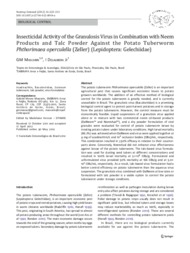Insecticidal activity of the granulosis virus in combination with neem products and talc powder against the potato tuberworm Phthorimaea operculella (Zeller) (Lepidoptera: Gelechiidae).
Insecticidal activity of the granulosis virus in combination with neem products and talc powder against the potato tuberworm Phthorimaea operculella (Zeller) (Lepidoptera: Gelechiidae).
Autoria: MASCARIN, G. M.; DELALIBERA JUNIOR, I.
Resumo: The potato tuberworm Phthorimaea operculella (Zeller) is an important agricultural pest that causes significant economic losses to potato growers worldwide. The addition of an effective method of biological control for the potato tuberworm is greatly needed, and is currently unavailable in Brazil. The granulosis virus (Baculoviridae) is a promising biological control agent to protect post-harvest potatoes and in storage from the potato tuberworm. However, the control measure must be economically feasible. Liquid suspensions of a granulosis virus applied alone or in mixture with two commercial neem oil-based products (DalNeem? and NeemAzal?), and a dry powder formulation of viral granules were evaluated for control of potato tuberworm larvae by treating potato tubers under laboratory conditions. High larval mortality (86.7%) was achieved when DalNeem and virus were applied together at 4 mg of azadirachtin/L and 104 occlusion bodies (OBs)/mL, respectively. This combination resulted in ≥50% efficacy in relation to their counterparts alone. Conversely, NeemAzal did not enhance virus effectiveness against larvae of the potato tuberworm. The talc-based virus formulation was used for dusting seed tubers at different concentrations and resulted in 100% larval mortality at 5×108 OBs/g. Formulated and unformulated virus provided 50% mortality at 166 OBs/g and at 5.0× 105 OBs/mL, respectively. As a result, talc-based virus formulation had a better control efficiency on potato tuberworm than the aqueous virus suspension. The granulosis virus combined with DalNeem at low rates or formulated with talc powder is a viable option to control the potato tuberworm under storage conditions.
Ano de publicação: 2012
Tipo de publicação: Artigo de periódico
Unidade: Embrapa Arroz e Feijão
Palavras-chave: Batata, Biological control, Controle biológico, Neem extracts, Nim, Phthorimaea operculella granulovirus, Praga de planta
Observações
1 - Por padrão são exibidas publicações dos últimos 20 anos. Para encontrar publicações mais antigas, configure o filtro ano de publicação, colocando o ano a partir do qual você deseja encontrar publicações. O filtro está na coluna da esquerda na busca acima.
2 - Para ler algumas publicações da Embrapa (apenas as que estão em formato ePub), é necessário ter, no celular ou computador, um desses softwares gratuitos. Sistemas Android: Google Play Livros; IOS: iBooks; Windows e Linux: software Calibre.
Acesse outras publicações
Acesse a Base de Dados da Pesquisa Agropecuária (BDPA) para consultar o acervo completo das bibliotecas da Embrapa.

